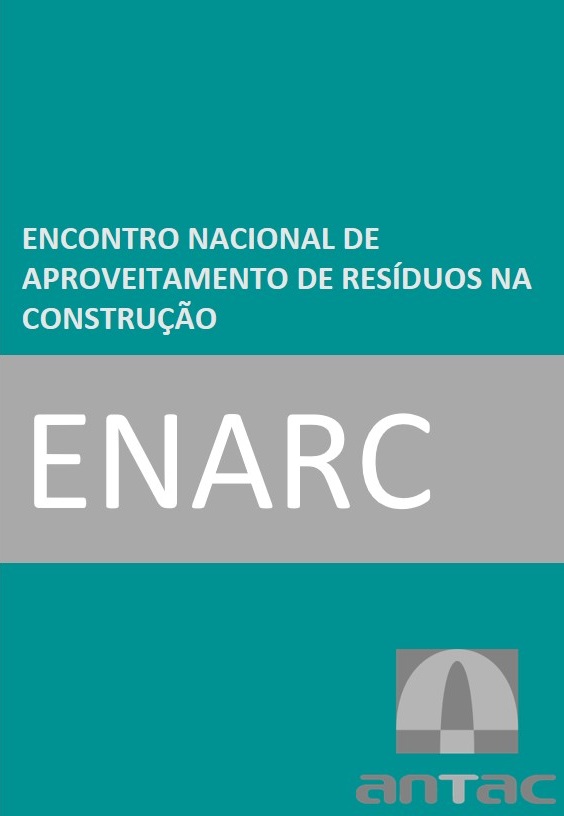Microstructure of cement paste with sugarcane bagasse ash under autoclave treatment
DOI:
https://doi.org/10.46421/enarc.v8i00.3030Keywords:
Microstructure of cementitious materials, Reactivity of sugar cane bagasse ash, Hydrated Calcium Silicate, Use of agro-industrial residuesAbstract
Portland cement stands as one of the most extensively used resources in the world, releasing CO2 emissions and depleting non-renewable natural resources. Additionally, Brazil holds the position of the world's largest sugar cane producer, generating a significant amount of waste. A potential solution to these environmental concerns involves replacing a portion of the cement mass by supplementary cementitious materials. Thus, this study aims to analyze the viability of integrating sugar cane bagasse ash (SCBA) into cementitious materials subjected to autoclave curing. Cement pastes with 25% SCBA were prepared and cured at room temperature or in autoclave conditions. The microstructure was examined using XRD, SEM, and hardness analysis. At room temperature, SCBA did not exhibit pozzolanic activity. However, under hydrothermal conditions, the SCBA reacted with Ca(OH)2, resulting in the formation of xonotlite. Consequently, the hardness of the CBCA sample increased nearly threefold following autoclave treatment.
References
CHEN, C. et al. Environmental impact of cement production: detail of the different processes and cement plant variability evaluation. Journal of Cleaner Production, v. 18, n. 5, p. 478–485, mar. 2010. https://doi.org/10.1016/j.jclepro.2009.12.014
CONSTANTINIDES, G.; ULM, F.-J. The effect of two types of C-S-H on the elasticity of cement-based materials: Results from nanoindentation and micromechanical modeling. Cement and Concrete Research, v. 34, n. 1, p. 67–80, jan. 2004. https://doi.org/10.1016/S0008-8846(03)00230-8
CORDEIRO, G. C.; TAVARES, L. M.; TOLEDO FILHO, R. D. Improved pozzolanic activity of sugar cane bagasse ash by selective grinding and classification. Cement and Concrete Research, v. 89, p. 269–275, nov. 2016. https://doi.org/10.1016/j.cemconres.2016.08.020
CWIRZEN, A. The effect of the heat-treatment regime on the properties of reactive powder concrete. Advances in Cement Research, v. 19, n. 1, p. 25–33, jan. 2007. https://doi.org/10.1680/adcr.2007.19.1.25
SOARES, M. M. N. S. et al. Comparing the pozzolanic behavior of sugar cane bagasse ash to amorphous and crystalline SiO2. Cement and Concrete Composites, v. 71, p. 20–25, ago. 2016. http://dx.doi.org/10.1016/j.cemconcomp.2016.04.005
FAIRBAIRN, E. M. R. et al. Cement replacement by sugar cane bagasse ash: CO2 emissions reduction and potential for carbon credits. Journal of Environmental Management, v. 91, n. 9, p. 1864–1871, set. 2010. https://doi.org/10.1016/j.jenvman.2010.04.008
GARCIA, D. C. S.; WANG, K.; FIGUEIREDO, R. B. The influences of quartz content and water-to-binder ratio on the microstructure and hardness of autoclaved Portland cement pastes. Cement and Concrete Composites, v. 91, p. 138–147, ago. 2018. https://doi.org/10.1016/j.cemconcomp.2018.05.010
IGARASHI, S.; BENTUR, A.; MINDESS, S. Microhardness testing of cementitious materials. Advanced Cement Based Materials, v. 4, n. 2, p. 48–57, set. 1996. https://doi.org/10.1016/S1065-7355(96)90051-6
LOTHENBACH, B.; SCRIVENER, K.; HOOTON, R. D. Supplementary cementitious materials. Cement and Concrete Research, v. 41, n. 12, p. 1244–1256, dez. 2011. https://doi.org/10.1016/j.cemconres.2010.12.001
RICHARD, P.; CHEYREZY, M. Composition of reactive powder concretes. Cement and Concrete Research, v. 25, n. 7, p. 1501–1511, out. 1995. https://doi.org/10.1016/0008-8846(95)00144-2
RICHARDSON, I. G. The calcium silicate hydrates. Cement and Concrete Research, v. 38, n. 2, p. 137–158, fev. 2008. https://doi.org/10.1016/j.cemconres.2007.11.005
TAM, C.; TAM, V. W. Microstructural behaviour of reactive powder concrete under different heating regimes. Magazine of Concrete Research, v. 64, n. 3, p. 259–267, mar. 2012. https://doi.org/10.1680/macr.2012.64.3.259
THOMAS, B. S. et al. Sugarcane bagasse ash as supplementary cementitious material in concrete – a review. Materials Today Sustainability, v. 15, p. 100086, nov. 2021. https://doi.org/10.1016/j.mtsust.2021.100086
YADAV, A. L. et al. An overview of the influences of mechanical and chemical processing on sugarcane bagasse ash characterisation as a supplementary cementitious material. Journal of Cleaner Production, v. 245, p. 118854, fev. 2020. https://doi.org/10.1016/j.jclepro.2019.118854
YAZICI, H.; DENIZ, E.; BARADAN, B. The effect of autoclave pressure, temperature and duration time on mechanical properties of reactive powder concrete. Construction and Building Materials, v. 42, p. 53–63, maio 2013. https://doi.org/10.1016/j.conbuildmat.2013.01.003

